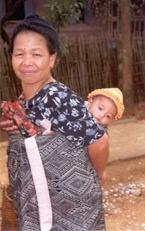The Tai Khang of China are a sub-group of the Dai, one of China's 55 officially recognized ethnic minorities. Most live in the southwestern corner of Yunnan province, near the Laotian border. A small number live over the border in Laos.
In Laos the Tai Khang homeland is characterized by beautiful mountains, valleys, and streams and has a subtropical, spring-like climate year-round. The years are not divided into summers and winters but rather into rainy and dry seasons. Palm trees, banana trees, and bamboo grow in abundance and the vast forests are inhabited by animals such as elephants, tigers, leopards, bears, monkeys and peacocks.
The overwhelming majority of the Tai Khang farm for a living. Rice, grown in irrigated fields, is by far the primary crop, but the Tai Khang usually reap a small harvest. Plowing, cultivating, planting, weeding and harvesting are still accomplished with primitive hand instruments such as wooden hoes and sickles. Other crops include tea, cotton, sugarcane, tobacco, coffee, pineapples and mangoes.
Typical Tai Khang villages have 30 to 40 households, although many settlements are larger. They are characterized by huge banyan trees and delicately designed Buddhist temples or pagodas. Among most Dai-related peoples, houses are made of bamboo and are built about six to nine feet above the ground on 21 wooden posts in three rows. The area below the home is used as a shelter for livestock and as a storage area. The walls and rafters are bamboo, while the roof is thatched. The interior of the house is divided lengthwise into two rooms.
In the past, when a boy reached the age of 8 or 9, he was sent to a Buddhist temple to live as a monk for at least two years, but more often, for ten years. At the temple, the boy received a new name. If he chose to leave and return to secular life, he received another new name. Upon the birth of his first child, he and his wife would both receive new names.
Many of the Tai Khang follow ancient Chinese folk religions. Chinese folk religion is characterized by a blending of religions. It has added Buddhist, Confucian and Taoist elements over the course of time and is centered on the concept of maintaining harmony. The Tai Khang consult horoscopes in an attempt to determine which course of action will promote harmony and bring good luck.
They also believe in a pantheon of spirits who inhabit the earth. The spirits of their ancestors supposedly roam the earth, and, if treated properly, are benign and bring good luck. Deities are supposedly the souls of people who lived especially virtuous lives. They are believed to have spiritual powers that they can use to benefit those who worship them.
The Tai Khang people in Laos have tremendous fear of the spirit world. Jesus Christ offers deliverance and life to the full if they would only turn to him. Who will be Christ bearers to the Tai Khang people in Lao?
Ask the Lord of the harvest to send forth laborers to share God's love with the Tai Khang.
Pray that God will give Laotian and Tai Khang believers boldness to share Christ.
Ask the Lord to bring forth a healthy and growing Tai Khang church that will multiply over and over again.
Ask the Lord to save key leaders among the Tai Khang who will boldly declare the gospel.
Scripture Prayers for the Tai Khang in Laos.
https://en.wikipedia.org/wiki/Tay_Khang_language
| Profile Source: Joshua Project |


























